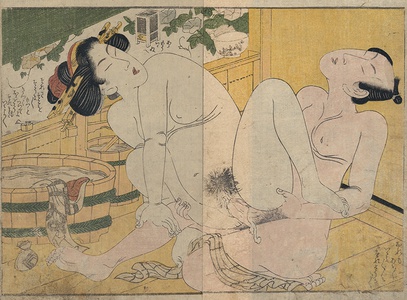| Method | Woodblock (nishiki-e) |
| Artist | attributed to Kikugawa Eizan (1787 - 1867) |
| Published | c. 1820 |
| Dimensions | Two Hanshibon sheets [each sheet ~222 x 155 mm] |
| Notes |
A man with a geisha in a moment of bliss in a bathhouse, their eyes closed in pleasure. Naked figures appear in ukiyo-e prints but the concept of the nude as genre in art did not appear until the introduction of Western painting styles after 1868; however, scenes in bath houses are not uncommon in ukiyo-e a whole and appear in shunga regularly. Japan had a long history of mixed public bathing that was part of the fabric of society until it was outlawed in 1791. While more strictly enforced in Edo and Kyoto is was less enforced in rural areas. It has been noted that segregated bathing lead to more peeping and the fetishised seeing the other sex naked thus heightening the sexual tension, taboo, and eroticism of these bathing prints. Shunga is the term used for the body of erotic imagery produced in Japan from 1600 to 1900. The term shunga means spring pictures and is a euphemism for sex and is one of several names for erotic material produced in Japan. Shunga took different formats: painted hand scrolls, painted books, printed books and albums and sets of prints which were sometimes sold in wrappers. As prints they are one of the genres of Ukiyo-e, or Floating World, prints which includes: fukeiga (landscape prints), and bijin-ga (prints of beautiful women). Most of the major Ukiyo-e artists produced shunga material at some point during their career including Utamaro (who produced more erotic books than non-erotic books), Hokusai, and Hiroshige. Produced at the same time as the introduction of full colour woodblock printing, shunga prints and books were made using the most lavish and complicated printing techniques including gauffage, metallic inks, mica, complicated printed patterns, and multicolour printing using a high number of different colours. Shunga whilst prolific is more representative of the idea of the Ukiyo-e or Floating World with an emphasis on mutual pleasure rather than an accurate representation of Japanese attitudes and practices of sexuality. Shunga prints present an invitation to pleasure through the bliss of lovemaking and though largely heteronormative, they portray the gambit of couplings married or otherwise often surrounded by lavish settings and objects of pleasure. Kikugawa Eizan (1787 - 1867) was a ukiyo-e prijt maker from Edo. His father Kikugawa Eiji, a amanufacture of fans and artifical flower,in additon to beinga painter of the Kano school and Eizan's first teacher. Eizan was the most prolific, longest-lived and ultimately the best of the late followers of Utamaro, who attempted to carry on the master's bijin style after his death in 1806.He also studied with the Shijo artist Suzuki Nanrei and the Hokusai pupil Hokkei. He produced some remarkable triptychs and vertical diptychs, as well as a few surimono. From 1810-13 Eizan began producing shunga He seems to have retired from printmaking in the late 1820s, though he did contribute illustrations for books even quite late in his life. Ex. Col.: Peter Darach Condition: Some rubbing and soiling lower right and left corners. |
| Framing | unmounted |
| Price | £300.00 |
| Stock ID | 53194 |

